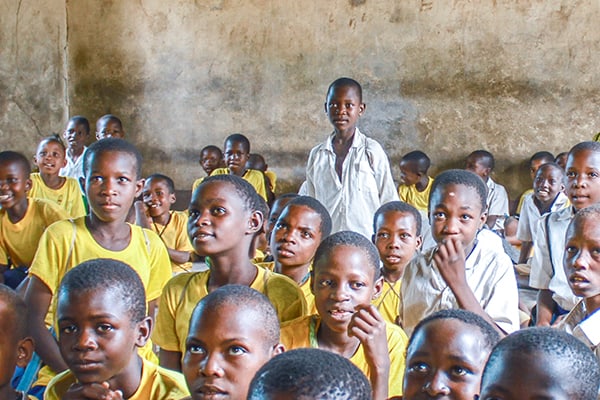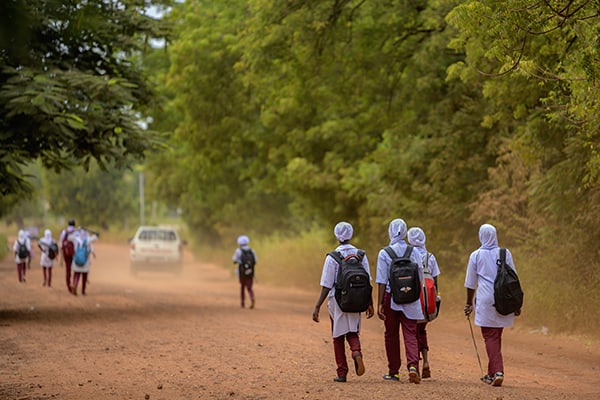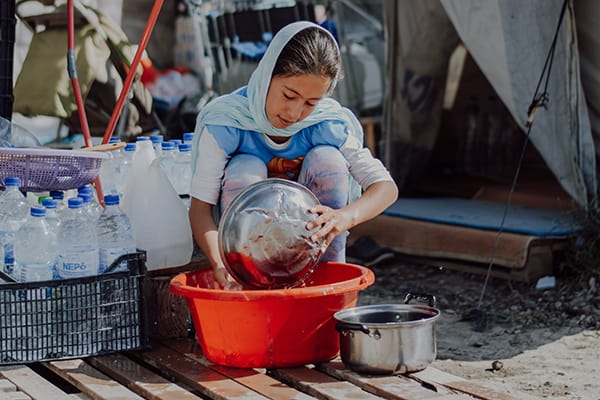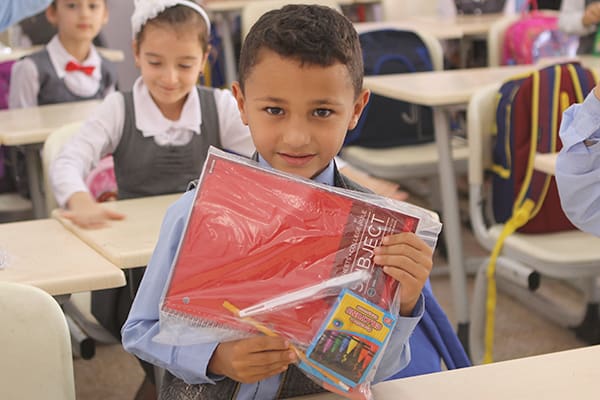How Children in the Toughest Places Balance Learning and Life
By Amanda DeWitt
Brightly colored backpacks. Freshly sharpened pencils. Crisp white paper filled with straight blue lines.
In just a few weeks, many children will be heading back to school. Their bright eyes will fill with wonder as they learn about math and science, language and art. Their minds will expand and grow as they take on new assignments and master new tasks.
As you prepare for the busyness of the back-to-school season, have you ever considered what life and learning look like for children in the toughest places?
Before you help your children pack up their backpacks, spend a few minutes together exploring what school days are like for others around the world. Then use our FREE download to help your children get ready for school by creating their own daily routine chart.
The Schoolhouse

In the toughest places school buildings vary just like the communities they serve. Children in urban areas may attend classes in a traditional building. The rooms may be filled with desks or tables and chairs.
Children living in smaller communities often walk to a one-room schoolhouse. If the school can afford it, they will have small plastic chairs for the students. But more often they make their own benches from stacked stones with a cut log set on top. Four to five children sit on each bench with a simple table set in front of them.
The teacher stands in front of the class with a blackboard. If more than one class is taking place in the schoolhouse, the building is divided in half — with one class learning from a teacher on one side and another class learning on the other. This can make hearing the teacher and concentrating on the lesson difficult at times.
In many places the schoolhouse has dirt floors. Splashing water on the floors minimizes dust. Students must carry a jerry can to school with them so they have water for drinking, hygiene, and cleaning. Sometimes classes must stop in the middle of the day to fetch additional water from a well.
In the most rural or remote regions, school may be held under a tree. A teacher will gather his/her students in a shaded place and teach the lessons outside using whatever supplies or materials accessible.
The Long Walk

For many children getting to school is not easy. Those living in remote areas may be forced to wake up around 4:30 am. They start walking to school around 5 am, while it is still dark outside. It is not uncommon for children to walk two to four miles each way to school — sometimes without shoes on their tender feet. After completing their classes, as early as 2 pm, children begin their long walk home.
Children who do not have access to a backpack, carry their school items in a plastic bag. Or they may simply hold their supplies in their arms, making the walk even more challenging.
If children are too young to walk the long distance to school, a family may make other arrangements. For one Kenyan family this meant sending their five-year-old daughter to her aunt’s house during the school week. Since her aunt’s home was closer to the school building, this allowed her to safely walk to school. She could then return home to her parents on the weekends.
The long, daily walks are not easy on children of any age — especially when they are hungry. With the growing global food crisis, many families have been forced to cut back on meals. Children may only receive milk or tea at home before walking to school. The lack of adequate nutrition makes the long walk even more challenging and can keep them from focusing in the classroom once they arrive.
Some schools provide a midday meal for students. Far too often this is the only nutrition children receive each day. But most children must bring their own lunch — if food is available for them to bring from home.
The Daily Responsibilities

Families in the toughest places must work together to make ends meet. Before and/or after school, children help with chores. They fetch water, collect firewood, or bring the livestock in from the field. Older children also help prepare meals and care for younger siblings.
At times daily responsibilities negatively impact a child’s ability to attend classes. For girls especially, household chores may require them go late or to stay home from school on certain days when their parents need additional help.
Despite all the progress that has been made, girls in the developing world are still less likely to complete primary or secondary school. The pandemic has also decreased access — for both boys and girls — to the classroom.
After children finish their household chores, they often have homework to complete. By this time it is often dark. Students must study next to the fire or near another light source. Without adequate rest, due to the early mornings and long days, it can be especially difficult to keep up with one’s daily assignments.
The Challenges Faced

Children in the toughest places want to learn. Families want to send their children to school. Communities want to help the next generation build a brighter future. But often they are faced with difficult choices.
With the rising costs of goods, many families are forced to choose between feeding their children or sending them school. In many developing countries, parents are required to pay school fees and purchase uniforms. They may also need to purchase workbooks or pencils. For many families living in poverty, they cannot afford the extra expenses.
Many schools also lack access to adequate supplies. They are simply not available. Textbooks can be expensive or difficult to obtain. If a school cannot afford enough pencils, teachers may be forced to cut each one into two or three pieces so each child can write and complete their lessons.
The Difference You Can Make
Going back to school in the toughest places is not easy. But you can help!
Your support of Unto® helps ship and deliver critical aid to families in need — meals, clothing, shoes, hygiene items, school supplies, and more. If you would like to make a gift as a family, visit unto.com/4xHope.
No matter where you live, getting your children into a daily routine is not easy. So we created a simple activity to help. Take advantage of our FREE download below. You will help your children get back to school a little easier — and be reminded of the difference your support and prayers make for children in the toughest places.
Help Your Children Get Back into the School Routine!
Children everywhere thrive on routine. As much as they may enjoy the flexibility of summertime, they focus and learn best when they know what to expect each day.
My Daily Routine chart is a FREE download designed to help you and your child establish a back-to-school (or anytime) schedule. Make a list of activities and chores together. Post the tasks on your child’s personalized daily routine chart and put it up where he/she can see it often. Give your child a sense of ownership and help him/her stay on track during busy school days.
Published August 10, 2022

Amanda is a freelance writer whose work has appeared in Gift for Leadership, Kindred Spirit, and Christianity Today publications. She holds a M.A. in Media and Communication from Dallas Theological Seminary.





